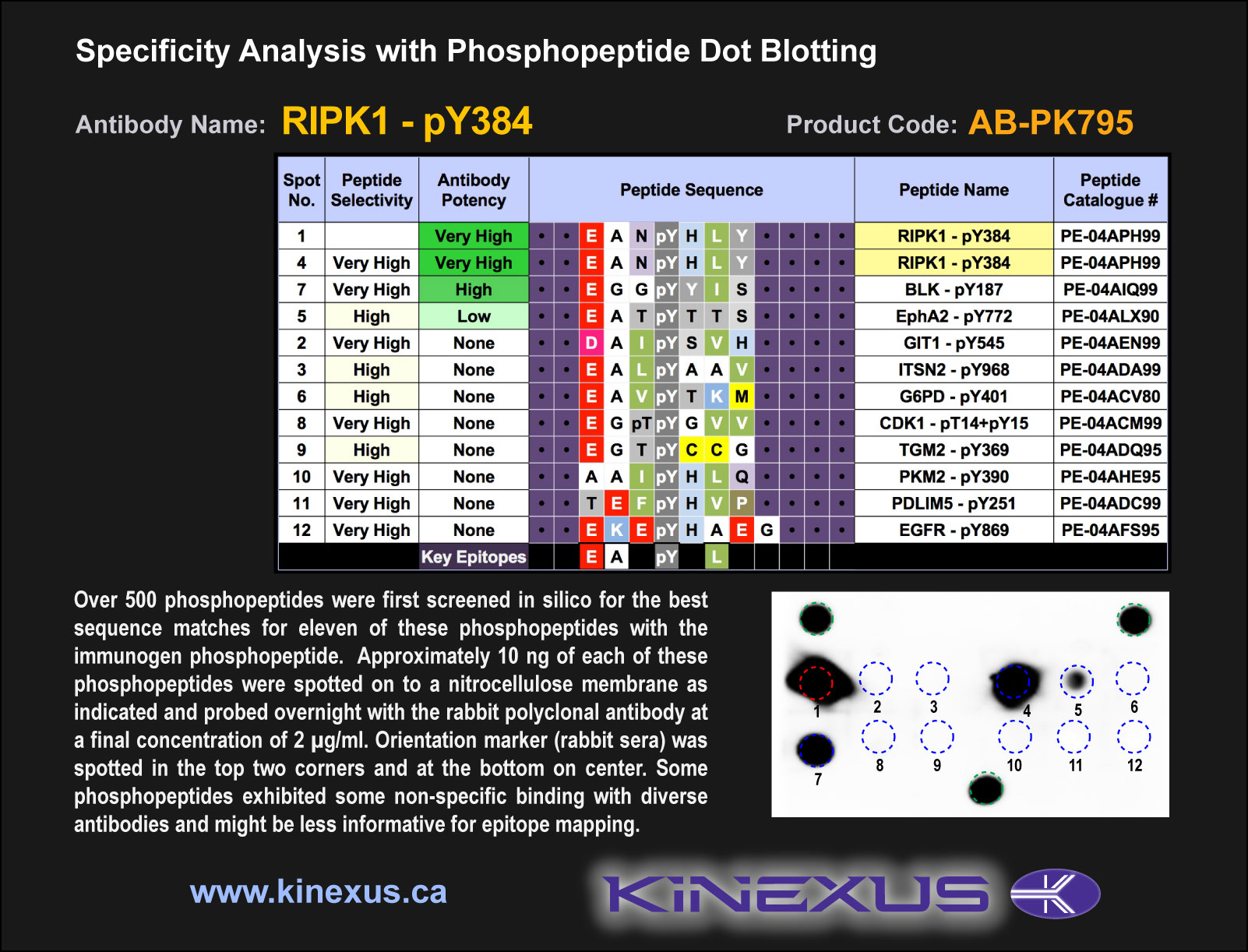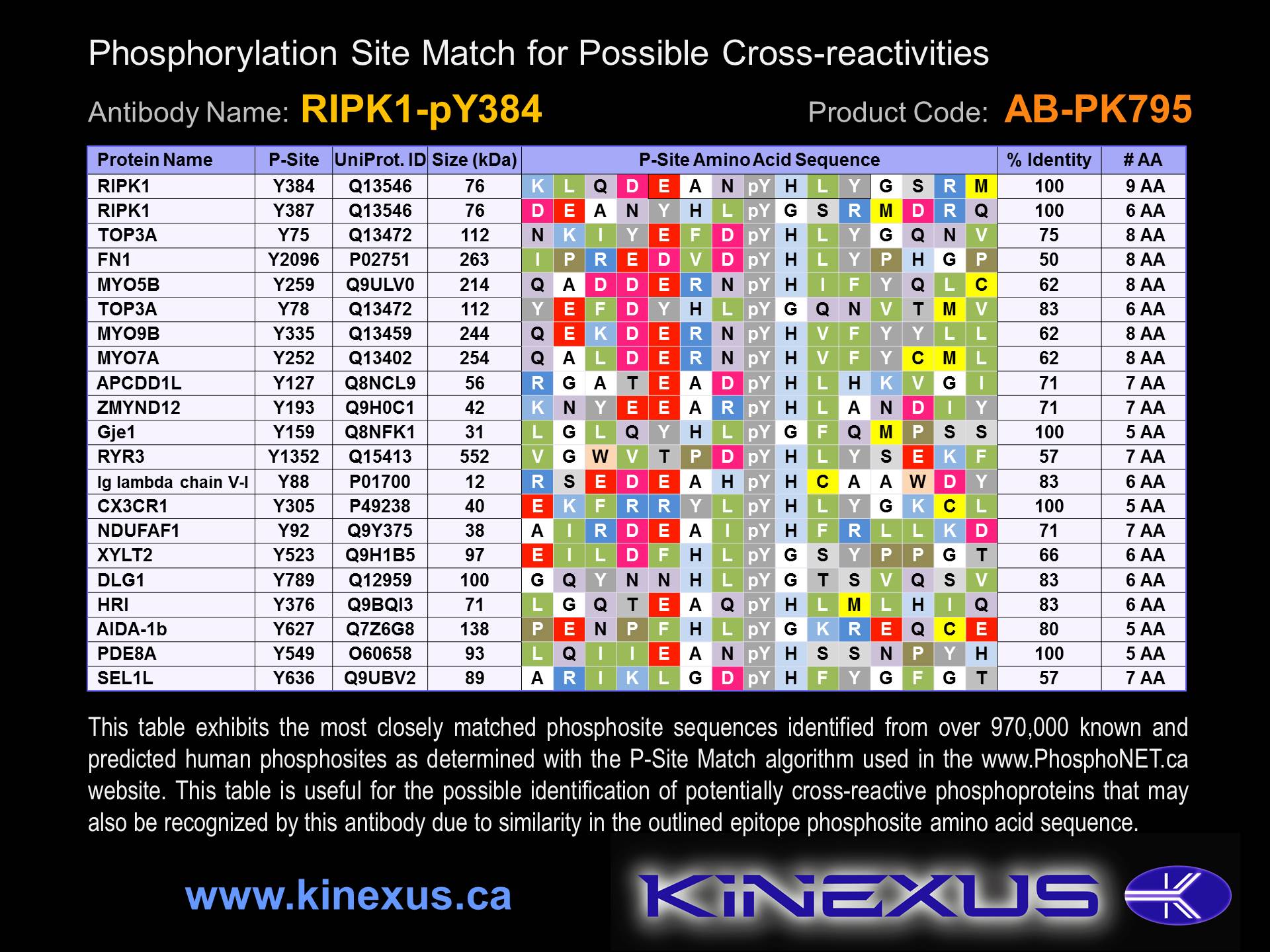Product Name: RIPK1-pY384
Product Number: AB-PK795
| Size: | 25 µg | Price: | 89.00 | |
| $US |
Target Full Name: Receptor-interacting protein-serine kinase 1
Target Alias: RIK1; RIP
Product Type Specific: Protein kinase phosphosite-specific antibody
Antibody Code: PK795
Antibody Target Type: Phosphosite-specific
Antibody Phosphosite: Y384
Protein UniProt: Q13546
Protein SigNET: Q13546
Antibody Type: Polyclonal
Antibody Host Species: Rabbit
Antibody Immunogen Source: Human RIPK1 sequence peptide Cat. No.: PE-04APH99
Target Alias: RIK1; RIP
Product Type Specific: Protein kinase phosphosite-specific antibody
Antibody Code: PK795
Antibody Target Type: Phosphosite-specific
Antibody Phosphosite: Y384
Protein UniProt: Q13546
Protein SigNET: Q13546
Antibody Type: Polyclonal
Antibody Host Species: Rabbit
Antibody Immunogen Source: Human RIPK1 sequence peptide Cat. No.: PE-04APH99
Antibody Immunogen Sequence: EAN(pY)HLY(bA)C
Antibody Immunogen Description: Corresponds to amino acid residues E381 to Y387; In the region between the kinase catalytic and RHIM domains. This is a major in vivo phosphorylation site in RIPK1.
Antibody Immunogen Description: Corresponds to amino acid residues E381 to Y387; In the region between the kinase catalytic and RHIM domains. This is a major in vivo phosphorylation site in RIPK1.
Production Method: The immunizing peptide was produced by solid phase synthesis on a multipep peptide synthesizer and purified by reverse-phase hplc chromatography. Purity was assessed by analytical hplc and the amino acid sequence confirmed by mass spectrometry analysis. This peptide was coupled to KLH prior to immunization into rabbits. New Zealand White rabbits were subcutaneously injected with KLH-coupled immunizing peptide every 4 weeks for 4 months. The sera from these animals was applied onto an agarose column to which the immunogen peptide was thio-linked. Antibody was eluted from the column with 0.1 M glycine, pH 2.5. Subsequently, the antibody solution was neutralized to pH 7.0 with saturated Tris.This antibody was also subject to negative purification over phosphotyrosine-agarose.
Antibody Modification: Unconjugated. Contact KInexus if you are interest in having the antibody biotinylated or coupled with fluorescent dyes.
Antibody Modification: Unconjugated. Contact KInexus if you are interest in having the antibody biotinylated or coupled with fluorescent dyes.
Antibody Concentration: 1 mg/ml
Storage Buffer: Phosphate buffered saline pH 7.4, 0.05% Thimerasol
Storage Conditions: For long term storage, keep frozen at -40°C or lower. Stock solution can be kept at +4°C for more than 3 months. Avoid repeated freeze-thaw cycles.
Product Use: Western blotting | Antibody microarray
Antibody Dilution Recommended: 2 µg/ml for immunoblotting
Antibody Potency: Very strong immunoreactivity with immunogen peptide on dot blots.
Antibody Species Reactivity: Human
Antibody Positive Control: The observed molecular mass of the processed target protein on SDS-PAGE gels is reported to be around 75-80 kDa.
Storage Buffer: Phosphate buffered saline pH 7.4, 0.05% Thimerasol
Storage Conditions: For long term storage, keep frozen at -40°C or lower. Stock solution can be kept at +4°C for more than 3 months. Avoid repeated freeze-thaw cycles.
Product Use: Western blotting | Antibody microarray
Antibody Dilution Recommended: 2 µg/ml for immunoblotting
Antibody Potency: Very strong immunoreactivity with immunogen peptide on dot blots.
Antibody Species Reactivity: Human
Antibody Positive Control: The observed molecular mass of the processed target protein on SDS-PAGE gels is reported to be around 75-80 kDa.
Antibody Specificity: Very high
Antibody Cross Reactivity: No significant cross-reactive proteins detected in HepG2 and T98G cells.
Related Product 1: RIPK1-pY384 blocking peptide
Antibody Cross Reactivity: No significant cross-reactive proteins detected in HepG2 and T98G cells.
Related Product 1: RIPK1-pY384 blocking peptide
Scientific Background: RIPK1 (RIP) is a protein-serine/threonine kinase of the TKL group and RIPK family. It has a role in inducing inflammation and necroptosis (programmed necrosis). RIPK1 has also been noted to function in the initial TLR3 recognition of dsRNA in a viral infection. A S161A mutation has been noted to decrease kinase phosphotransferase activity of RIPK1. A S161E mutation has no effect on autophosphorylation of RIPK1. Caspase-8-mediated RIPK1 cleavage is impaired through a D324K mutation. NF-kB induction through RIPK1 can be inhibited via a K377R mutation. The phosphotransferase activity of RIPK1 and its NF-kB activation are, surprisingly, not essential for the anti-apoptotic function of this protein in epithelial tissues.
Figure 1. Epitope mapping of RIPK1-pY384 antibody with similar phosphopeptides on dot blots.
Figure 2. Identification of phosphosites related to RIPK1-pY384.
© Kinexus Bioinformatics Corporation 2017



